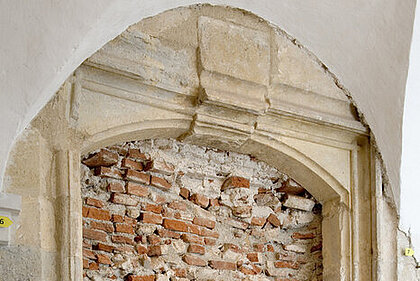In 1625 Prince Hans Ulrich von Eggenberg selected the exact same place chosen as the site of the family seat by his great-grandfather, Balthasar Eggenberger, one and a half centuries earlier for the construction of the new residence. Parts of the previous medieval castle were, however, kept and incorporated into the newly constructed Baroque four-winged palace. The central tower with its gothic chapel even became the very core of the new palace. Traces of this medieval structure are still being discovered today.
Gothic Eggenberg
Eckhenperg- the ancestral seat on the fields of Algersdorf
Balthasar Eggenberger purchased the “Orthof” on the fields of Algersdorf, just one mile to the west of the city of Graz before 1464. Over the following years he had this fortified manor house extensively converted and expanded. At present only little can be said regarding the appearance of the family’s ancestral seat. It probably consisted of a free-standing square tower and an L-shaped building. A small sanctuary of the Virgin Mary was constructed in the tower prior to 1470 and it was furnished with a precious winged altar.
Generations to follow also carried out numerous alterations to the building, but it wasn’t until Hans Ulrich von Eggenberg became an important statesman that this modest family seat no longer reflected his and his family’s newfound status. Conversion of the old castle began in 1625; the medieval sections were, however, not dismantled, but cleverly incorporated into the new residence. This was partly due to the economic necessity to save on building materials, but also due to his apparent desire to keep the “family seat” and thus not destroy the family’s dynastic inheritance.
A few older building structures dating back to the 15th and 16th century are still being discovered today. In the rear wings of the palace there are some older façades, a portal and window framings with coloured façade designs. The gothic chapel with the sanctuary of the Virgin Mary on the second floor of the tower actually remained unchanged and even became the very core of the new palace.

Image Credits

Image Credits

Image Credits
Gothic chapel
Balthasar Eggenberger had a sanctuary of the Virgin Mary constructed in the tower of his estate in 1470. This "capella Beate Marie Virginis sita in Castro Eckenperg" - as it is named in an indulgence document - forms the nucleus of the castle built by his famous descendant, Prince Hans Ulrich. The square room with its magnificent vaulted ceiling is typical of Late Gothic architecture and one of a whole Europe-wide tradition of prestigious private chapels found on aristocratic estates. The small chapel itself also symbolises the significance of Christian beliefs for the people of the Middle Ages. Balthasar was definitely not a deeply religious man, but it was still important to him to ensure his own salvation after his death. He therefore donated a winged alter dedicated to the highest of all advocates, the Virgin Mary.

Image Credits

Image Credits

Image Credits
The Eggenberg Altarpiece
In the face of the unsettled times, it was only natural to look to Mary Help of Christians for protection. Thus, the Mother of God is also placed in the centre of the magnificent Eggenberg retable, which was donated by Balthasar prior to 1470. The 13 panels of the retable can still be seen today, while the altar structure was dismantled in the 18th century. The Virgin Mary is surrounded by angels with musical instruments and flanked by St. Fabian and St. Sebastian. Among the immediate entourage of the celestial queen were four exalted female martyrs: Dorothea, Margaret, Catherine and Barbara depicted next to the central panel. The twelve apostles take up the inner wings of the altar, whereas the outer sides show 12 of the "14 Holy Helpers", who were particularly popular in those days.
Winged altars were only opened on important church holidays in the Middle Ages. This also explains the enormous efforts taken to decorate the inside: The gold background and precious carved altar architecture is reflected in the magnificent garments of saints depicted. Compared to the other Styrian panels of the late gothic period, the Eggenberg altarpiece is unique in every respect, and thus proof of the family's significant position in society in the fifteenth century.

Image Credits

Image Credits

Image Credits




















